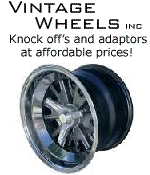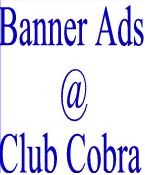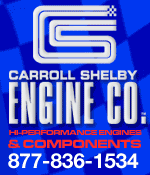 
 Main Menu
Main Menu
|
 Nevada Classics
Nevada Classics
|
 Advertise at CC
Advertise at CC
|
 November 2024
November 2024
|
| S |
M |
T |
W |
T |
F |
S |
| |
|
|
|
|
1 |
2 |
| 3 |
4 |
5 |
6 |
7 |
8 |
9 |
| 10 |
11 |
12 |
13 |
14 |
15 |
16 |
| 17 |
18 |
19 |
20 |
21 |
22 |
23 |
| 24 |
25 |
26 |
27 |
28 |
29 |
30 |
|
 CC Advertisers
CC Advertisers
|
|

11-01-2006, 08:36 AM
|
 |
CC Member

|
|
|
Join Date: Mar 2005
Location: Santa Cruz,
ca
Cobra Make, Engine: Shelby CSX4788 with a Dawkins performance 490 ci iron genesis block hydrualic roller
Posts: 246
|
|

 Not Ranked
Not Ranked
 Fuel plumbing for an FE
Fuel plumbing for an FE
Hey Gang,
I am the proud owner of csx4788 which will hopefully be finished soon. I am having some problems with the fuel system and got into a discussion with my race car mentor. I am currently running the two -6 hoses from the two fuel pumps into a fuel block into the 3/8 " pipe connector to a holley fuel pressure regulator to a larhe summit racing fuel filter out a -8 aeroquip line to a -8 aeroquip fuel log to a holley 4150 750 cfm double pumper and measuring fuel pressure off the other end of the fuel log. The motor is a 1965 HM 427 (~10:1) side oiler with edlebrock heads (modified for a 2.19" intake) that should be putting out ~ 525 hp at the fly wheel. My mentor is telling me that I will not have enough fuel flow to the carb and that it would be better to move the regulator to the carb, run -8 line from the fuel block to the filter and -8 line from the filter to the 3/8 connector on the regulator and then (2) -6 lines from the regulator to the carb. Will I really get that much more flow by replumbing it as suggested? Is my flow truly going to be inadequate as it is plumbed right now? Thanks.
John(;-)
__________________
Racing, bull fighting and mountain climbing are the only true sports, everything else is just a game. - Hemmingway
|
-
Advertising


11-03-2006, 12:11 AM
|
|
CC Member

|
|
|
Join Date: Jun 2003
Cobra Make, Engine: ERA 427 w/496 Side Oiler, roller, dual quads
Posts: 417
|
|

 Not Ranked
Not Ranked
I go by the rule of thumb that a 3/8" line is good for 400 hp. Therefore, individual 3/8" (-6) line from the tank to each pump, the same to where they meet, and 1/2" (-10) to the regulator, and you can go -6 to each carb if you're running two, or best to stick with -10 if you're only runing one carb.
In other words, yeah, like he said. 
JHMO,
Dan
__________________
Do you know why they call it "PMS"? Because "Mad Cow Disease" was taken. --Unknown, presumed deceased
|

11-16-2006, 07:10 PM
|
 |
CC Member

|
|
|
Join Date: Jul 2004
Location: Alpharetta,
GA
Cobra Make, Engine: ERA #414 427 s/o w. Shelby Aluminum heads, Edelbrock Performer RPM Intake, Mighty Demon 750, Tremec TKO 600
Posts: 714
|
|

 Not Ranked
Not Ranked
My understanding is that it's all about where the constraint is in the system so you want the smallest diameter line at the carb, with everything in "front" of that going up one size at each major connection back toward the tank. Seems having any -6 lines in the flow before the -10 is going to limit you to the -6 flow rate. But with 2 -6 lines feeding one -10 line, then it's hard to say - would that be the equivalent of a -12 feeding a -10 and then into a -6? Also, putting the regulator near the carb makes sense as that's where you need the pressure to be regulated - going into the float bowls. And won't do you any good for the lines to the carb to be any bigger than the inlets. As for how much difference in flow, there's too much science in that answer for me :-)
|

11-16-2006, 08:11 PM
|
|
CC Member

|
|
|
Join Date: Apr 1999
Location: cleveland,
OH
Cobra Make, Engine: CSX4000, 427
Posts: 1,999
|
|

 Not Ranked
Not Ranked
Quote:
|
Originally Posted by HSSS427
But with 2 -6 lines feeding one -10 line, then it's hard to say - would that be the equivalent of a -12 feeding a -10 and then into a -6?
|
If I remember correctly, I believe the AN stands for Army-Navy , and the number is the diameter of the tube, such that you take the number / 16, and that's the diameter in inches. 2 6-AN's do not equal 1 12-AN line, the 12-AN line will flow more. Going from cross sectional area alone, I would think 2 6-AN's will flow alittle more than one 8-AN, but not as much as 1 10-AN, and definitely not as much as one 12-AN, which may be equal to about 4 6-AN lines.
My guess is that since cross sectional area is a function of radius (diameter) squared, you square the number to get the relative cross sectional area, so a 6-AN line would have a relative area of 36, 8-AN would have 64, 10-AN would be 100, and a 12-AN would be 144.
__________________
"After jumping into an early lead, Miles pitted for no reason. He let the entire field go by before re-entering the race. The crowd was jumping up and down as he stunned the Chevrolet drivers by easily passing the entire field to finish second behind MacDonald's other team Cobra. The Corvette people were completely demoralized."
Last edited by Anthony; 11-16-2006 at 08:14 PM..
|

11-16-2006, 08:20 PM
|
 |
CC Member

|
|
|
Join Date: Jul 2004
Location: Alpharetta,
GA
Cobra Make, Engine: ERA #414 427 s/o w. Shelby Aluminum heads, Edelbrock Performer RPM Intake, Mighty Demon 750, Tremec TKO 600
Posts: 714
|
|

 Not Ranked
Not Ranked
I knew someone would bail me out on that - thanks Anthony!
|

11-16-2006, 11:32 PM
|
|
CC Member

|
|
|
Join Date: Jun 2003
Cobra Make, Engine: ERA 427 w/496 Side Oiler, roller, dual quads
Posts: 417
|
|

 Not Ranked
Not Ranked
oooooooops
__________________
Do you know why they call it "PMS"? Because "Mad Cow Disease" was taken. --Unknown, presumed deceased
Last edited by Carnut427; 11-16-2006 at 11:37 PM..
|

11-16-2006, 11:34 PM
|
|
CC Member

|
|
|
Join Date: Jun 2003
Cobra Make, Engine: ERA 427 w/496 Side Oiler, roller, dual quads
Posts: 417
|
|

 Not Ranked
Not Ranked
Quote:
|
Originally Posted by HSSS427
...Seems having any -6 lines in the flow before the -10 is going to limit you to the -6 flow rate...
|
The -6 lines each feed a separate pump, -6 lines come from each pump to a "Y" where they meet and go into a -10 from there. Each pump on my system gets fuel from a different side of the fuel tank; when I raced the car it would starve for fuel on the corners, this solved that problem. My car runs on two pumps 99% of the time, so they each get fed by and feed the -6 line until they can meet at a convenient spot and go into the -10.
My regulator is beside the two carbs, with a 3/8" (-6) line going to each carb.
Dan
__________________
Do you know why they call it "PMS"? Because "Mad Cow Disease" was taken. --Unknown, presumed deceased
|

11-17-2006, 06:49 AM
|
 |
CC Member

|
|
|
Join Date: Jul 2004
Location: Alpharetta,
GA
Cobra Make, Engine: ERA #414 427 s/o w. Shelby Aluminum heads, Edelbrock Performer RPM Intake, Mighty Demon 750, Tremec TKO 600
Posts: 714
|
|

 Not Ranked
Not Ranked
OK, but to Anthony's point, is the flow from the combination of the two -6 lines greater than, or less than the flow potential of the single -10 line. If it's less, then you may want to change those -6 lines to something larger to remove the "constraint" and maximize flow up to the carb. So, answer may be: change the -6 lines to something bigger and move the regulator up to the carb end of the -10 line.
Of course the simpler answer is to actually figure out the flow rate you're getting and determine if that is indeed sufficient before making any changes. Could spend a lot of time and money based on theory when in fact there isn't an issue - which I always find myself doing despite this advice  I think I have some weird need to have more projects to do on the car vs just going and driving it  |

11-17-2006, 11:32 AM
|
|
CC Member

|
|
|
Join Date: Jun 2003
Cobra Make, Engine: ERA 427 w/496 Side Oiler, roller, dual quads
Posts: 417
|
|

 Not Ranked
Not Ranked

Quote:
|
Originally Posted by HSSS427
OK, but to Anthony's point, is the flow from the combination of the two -6 lines greater than, or less than the flow potential of the single -10 line. If it's less, then you may want to change those -6 lines to something larger to remove the "constraint" and maximize flow up to the carb. So, answer may be: change the -6 lines to something bigger and move the regulator up to the carb end of the -10 line.
|
This has gotten complicated, sorry I didn't make myself clear: I posted to help shelby racer; my car runs fine. Let's change my -6 and -10 designations to their fractional equivalents. I have two separate pumps from the tank, each feeding 3/8" diameter lines, which converge into one 1/2" diameter line. My two 3/8" lines are roughly the equivalent of one 3/4" line, making the 1/2" line the restriction, but it flows plenty for my engine. From the regulator I again have two 3/8" diameter lines, one going to each carb.
Quote:
|
Originally Posted by HSSS427
I think I have some weird need to have more projects to do on the car vs just going and driving it  |
Me too. It's like having my very own personal black hole, sucking money out of my wallet.  However, I have no desire (or enough courage?  ) to stop. I'm always looking at "improvements" or merely changes. It's truly a disease with no known cure. 
__________________
Do you know why they call it "PMS"? Because "Mad Cow Disease" was taken. --Unknown, presumed deceased
Last edited by Carnut427; 11-17-2006 at 11:48 AM..
|

11-17-2006, 03:47 PM
|
|
CC Member

|
|
|
Join Date: Apr 1999
Location: cleveland,
OH
Cobra Make, Engine: CSX4000, 427
Posts: 1,999
|
|

 Not Ranked
Not Ranked
Quote:
|
Originally Posted by HSSS427
OK, but to Anthony's point, is the flow from the combination of the two -6 lines greater than, or less than the flow potential of the single -10 line. If it's less, then you may want to change those -6 lines to something larger to remove the "constraint" and maximize flow up to the carb. So, answer may be: change the -6 lines to something bigger and move the regulator up to the carb end of the -10 line.
|
If your pumps are not resticted by 6AN lines, then changing to anything bigger wouldn't matter. I would think the 10AN line should still have less resistance than the two 6AN lines combined, and, again, if the pumps are not restricted, then there's no point in upsizing the lines from the pump.
__________________
"After jumping into an early lead, Miles pitted for no reason. He let the entire field go by before re-entering the race. The crowd was jumping up and down as he stunned the Chevrolet drivers by easily passing the entire field to finish second behind MacDonald's other team Cobra. The Corvette people were completely demoralized."
|

11-17-2006, 03:49 PM
|
|
CC Member

|
|
|
Join Date: Apr 1999
Location: cleveland,
OH
Cobra Make, Engine: CSX4000, 427
Posts: 1,999
|
|

 Not Ranked
Not Ranked
Quote:
|
Originally Posted by Carnut427
Let's change my -6 and -10 designations to their fractional equivalents. I have two separate pumps from the tank, each feeding 3/8" diameter lines, which converge into one 1/2" diameter line. My two 3/8" lines are roughly the equivalent of one 3/4" line, making the 1/2" line the restriction,
|
two 3/8 lines do not equal one 3/4 line.
__________________
"After jumping into an early lead, Miles pitted for no reason. He let the entire field go by before re-entering the race. The crowd was jumping up and down as he stunned the Chevrolet drivers by easily passing the entire field to finish second behind MacDonald's other team Cobra. The Corvette people were completely demoralized."
|

11-18-2006, 12:39 AM
|
|
CC Member

|
|
|
Join Date: Jun 2003
Cobra Make, Engine: ERA 427 w/496 Side Oiler, roller, dual quads
Posts: 417
|
|

 Not Ranked
Not Ranked
Quote:
|
Originally Posted by Anthony
two 3/8 lines do not equal one 3/4 line.
|
You're right, there is more wall area on the two 3/8" lines causing more restriciton, so I said they are roughly equivalent to one 3/4" line.
Your input is appreciated, Anthony. You've got a lot of knowledge stored in that cranium of yours. 
Dan
__________________
Do you know why they call it "PMS"? Because "Mad Cow Disease" was taken. --Unknown, presumed deceased
|

11-18-2006, 04:50 AM
|
|
CC Member

|
|
|
Join Date: Oct 2000
Location: Crystal Lake,
IL
Cobra Make, Engine: Everett-Morrison, 434 cid
Posts: 977
|
|

 Not Ranked
Not Ranked
Compared to 1 -12 line, 2 -06 lines are roughly half.
2 -06 lines are roughly 74% of 1 -10 line and roughly 23% more than 1 -08 line.
-06 = .344 dia
-08 = .438
-10 = .562
-12 = .688
|

11-18-2006, 07:11 AM
|
|
CC Member

|
|
|
Join Date: Apr 1999
Location: cleveland,
OH
Cobra Make, Engine: CSX4000, 427
Posts: 1,999
|
|

 Not Ranked
Not Ranked
Quote:
|
Originally Posted by Carnut427
there is more wall area on the two 3/8" lines causing more restriciton, so I said they are roughly equivalent to one 3/4" line.
|
The major factor for flow resistance is cross sectional area, which is a function of the square of the radius (diameter). Wall area is a minor factor, and doesn't really only come into play if you have two conduits with the same cross sectional area even though one has more wall circumference. The one with the greater wall circumference will have slightly higher resistance to flow due to higher boundry layer-flow interface, and therefore flow slightly less. The greater wall circumference effect would only be very significant if the cross sectional area is really small to begin with, or there is a very large discrepency between the two conduits minimum diameter or wall circumference.
__________________
"After jumping into an early lead, Miles pitted for no reason. He let the entire field go by before re-entering the race. The crowd was jumping up and down as he stunned the Chevrolet drivers by easily passing the entire field to finish second behind MacDonald's other team Cobra. The Corvette people were completely demoralized."
|

11-18-2006, 10:40 AM
|
|
CC Member

|
|
|
Join Date: Apr 1999
Location: cleveland,
OH
Cobra Make, Engine: CSX4000, 427
Posts: 1,999
|
|

 Not Ranked
Not Ranked

Dan,
as cross sectional area determines max flow capabilities, the cross sectional area of a circle is pie*r*r, or pie*d*d/4. So, if I have a 2" ID pipe, the cross sectional area would be 3.141 sq inches. If I have a pipe twice in diameter, 4 inches, then the cross sectional area is 12.564 sq inches, 4 X as much. Therefore a 6AN hose has a 3/8" ID, and a 12AN hose, twice the diameter, has a 3/4" ID, the 12AN hose has 4X the cross sectional area, more area for fluid to flow, and should flow about 4X as much as a single 6AN. So, it would take 4 6AN lines to flow about as much as a single 12AN line. However, what you said before is correct as well, in that wall resistance does come into play, and if the cross sectional areas of 4 6AN lines and a single 12AN line are exactly the same, the 12 AN line would flow a little more than the 4 6AN lines due to wall resistance, and would be variable from 1% to 10, 20, 30% dependent upon on the flow rate and viscosity of the fluid, with higher flow rates and higher viscosity fluids having a greater loss to resistance in the 4 6AN lines, and a greater diofference comparing it to the single 12AN line.
Not to open another can of worms, but this also has ramifications in cylinder port design, not that I'm any expert on the subject, but I do like the theory. With an exhaust port, which is purely hot gas, I would think you would want round exhaust ports as an optimal design, with less wall-gas injterface not only for flow resistance , but also less heat transfer. However, you also don;t want a sharp bend in the short side radius, so you may want to raise the floor alittle, blunting the bottom of the circle, to enhance flow in the bottom of the port. With the intake port, it is more complex, as you have a mixture of air and liquid/vapor fuel. You may want more of a square port than a round port, utilizing a flat bottom, for more wall space for fuel to be vaporized, so a round port on the intake side may not be optimal even though a round port is optimal for flow alone, with again taking in consifderation of the short side radius of the port.
As I have found out many times, things are usually alot more complicated than what they appear to be in the first place.
__________________
"After jumping into an early lead, Miles pitted for no reason. He let the entire field go by before re-entering the race. The crowd was jumping up and down as he stunned the Chevrolet drivers by easily passing the entire field to finish second behind MacDonald's other team Cobra. The Corvette people were completely demoralized."
Last edited by Anthony; 11-18-2006 at 10:44 AM..
|

11-18-2006, 10:56 AM
|
 |
CC Member

|
|
|
Join Date: Mar 2005
Location: Santa Cruz,
ca
Cobra Make, Engine: Shelby CSX4788 with a Dawkins performance 490 ci iron genesis block hydrualic roller
Posts: 246
|
|

 Not Ranked
Not Ranked
 Uhhhh - wow!
Uhhhh - wow!
Thanks for all the input. Maybe I can make this question a little easier. My csx4750 series came plumbed from the factory with two fuel pumps in the trunk running (2) -6 lines into the engine compartment. I planned on running them into a junction block, into a Holley fuel pressure regulator, into a large summit fuel filter into -8 aeroquip line to a single Holley 4150hp 750cfm double pumper with an aeroquip -8 fuel log and measuring fuel pressure off the other end (after it feeds the carb) on a 1965 427 (30 over) side oiler with edlebrock aluminum heads (Intake = 2.19, exhaust=2.09) rated at ~525 gross / crankshaft hp. Does anyone have actual experience with a similar set up and will it be adequate for a spiritedly driven street car (I already have enough racing mustangs for the track). The car is already plumbed this way, but I am still struggling with getting it finished and running, so I can still change it if I have to, but I don't want to have to replumb it. Thanks again.
John(;-)
__________________
Racing, bull fighting and mountain climbing are the only true sports, everything else is just a game. - Hemmingway
|

11-18-2006, 11:20 AM
|
|
CC Member

|
|
|
Join Date: Apr 1999
Location: cleveland,
OH
Cobra Make, Engine: CSX4000, 427
Posts: 1,999
|
|

 Not Ranked
Not Ranked

Quote:
|
Originally Posted by shelby racer
My csx4750 series came plumbed from the factory with two fuel pumps in the trunk running (2) -6 lines into the engine compartment. I planned on running them into a junction block, into a Holley fuel pressure regulator, into a large summit fuel filter into -8 aeroquip line to a single Holley 4150hp 750cfm double pumper with an aeroquip -8 fuel log and measuring fuel pressure off the other end (after it feeds the carb) on a 1965 427 (30 over) side oiler with edlebrock aluminum heads (Intake = 2.19, exhaust=2.09) rated at ~525 gross / crankshaft hp. Does anyone have actual experience with a similar set up and will it be adequate for a spiritedly driven street car (I already have enough racing mustangs for the track).
|
That's kind of the way my car is. It should be fine. I have both electric pumps pumping through the same 6AN line, then a suction 6AN line to my mechanical pump, with its outflow to a junction block with the 6AN line from the electric pumps, and out from the junction block with a 8AN line. Should be fine.
__________________
"After jumping into an early lead, Miles pitted for no reason. He let the entire field go by before re-entering the race. The crowd was jumping up and down as he stunned the Chevrolet drivers by easily passing the entire field to finish second behind MacDonald's other team Cobra. The Corvette people were completely demoralized."
|

11-18-2006, 11:25 AM
|
|
CC Member

|
|
|
Join Date: Jun 2003
Cobra Make, Engine: ERA 427 w/496 Side Oiler, roller, dual quads
Posts: 417
|
|

 Not Ranked
Not Ranked

Quote:
|
Originally Posted by Anthony
Dan,
as cross sectional area determines max flow capabilities, the cross sectional area of a circle is pie*r*r, or pie*d*d/4. So, if I have a 2" ID pipe, the cross sectional area would be 3.141 sq inches. If I have a pipe twice in diameter, 4 inches, then the cross sectional area is 12.564 sq inches, 4 X as much. Therefore a 6AN hose has a 3/8" ID, and a 12AN hose, twice the diameter, has a 3/4" ID, the 12AN hose has 4X the cross sectional area, more area for fluid to flow, and should flow about 4X as much as a single 6AN. So, it would take 4 6AN lines to flow about as much as a single 12AN line...
As I have found out many times, things are usually alot more complicated than what they appear to be in the first place.
|
I stand corrected. Although I was a machinist and not an engineer, I did some research once at work concerning flow in steel pipe, and found the same info you report, that when you double the size you quadruple the flow, although for some reason I thought it only applied to steel piple, where a 1" pipe is actually a nominal sizing, and didn't realize it applied to tubing or -AN sizes as well. Thanks for the info, I'll reconfigure the info in my memory bank. BTW, I also found that one 90* bend creates as much resistance as 8' of straight pipe. We were having problems getting enough oil flow in some machinery, causing premature bearing failures.
By the way, the car still runs great...going back to my original rule of thumb of one 3/8" fuel line will support 400 hp, my two 3/8" lines are still good for 800 hp, although, thanks to you, I'm beginning to have doubts about that too... 
Dan
__________________
Do you know why they call it "PMS"? Because "Mad Cow Disease" was taken. --Unknown, presumed deceased
|

11-18-2006, 12:16 PM
|
|
CC Member

|
|
|
Join Date: Apr 1999
Location: cleveland,
OH
Cobra Make, Engine: CSX4000, 427
Posts: 1,999
|
|

 Not Ranked
Not Ranked

Quote:
|
Originally Posted by Carnut427
BTW, I also found that one 90* bend creates as much resistance as 8' of straight pipe. We were having problems getting enough oil flow in some machinery, causing premature bearing failures. |
Whan I plumbed my car, I tried to use the radiused fittings on all fuel and oil ends, trying to avoid 90 elbow bends. I couldn't do so on the outflow of the mechanical fuel pump, so it has a 90 elbow, as well as the oil return line back at the block.
There's a 90 elbow inside the remote oil filter mount itself, the center outflow, although I took it apart, and tried to chamfer the corner, trying to make it into two 45 degree bends, but if I remember correctly, I think it was already like two 45 degree bends instead of a single 90.
With 90 elbows, I had thought about putting a little epoxy in the long radius, corner, of a 90 elbow fitting, again to try to make it into two 45 bends instead of a single 90 to try and smooth out the flow. I actually think I did this in the 90 elbow outflow from the mechanical fuel pump, but I can't remember for sure, as I'd have to take the fitting off to reinspect it. I know I didn't do it on the oil return elbow to the engine block. It would really have to tested to see if it really makes any difference, but again, I do think I put some epoxy inside the elbow fitting on my fuel system, like this.

__________________
"After jumping into an early lead, Miles pitted for no reason. He let the entire field go by before re-entering the race. The crowd was jumping up and down as he stunned the Chevrolet drivers by easily passing the entire field to finish second behind MacDonald's other team Cobra. The Corvette people were completely demoralized."
|

11-18-2006, 12:53 PM
|
|
CC Member

|
|
|
Join Date: Oct 2000
Location: Crystal Lake,
IL
Cobra Make, Engine: Everett-Morrison, 434 cid
Posts: 977
|
|

 Not Ranked
Not Ranked
Fuel pump and fuel line minimum requirements are based on HP.
The basic rule of thumb is:
up to 375 HP requires a minimum of a -06 line.
376 - 550 HP requires a -08 line
551 - 800 HP requires a -10 line
For a deadhead system the formula for determining the minimum fuel pump GPH rating is:
HP x .23 = GPH
example: 525 x .23 = 120.8 GPH
For a return system the formula is:
HP x .17 = GPH
example: 525 x .17 = 89.2 GPH
The next component after the regulator should be the carburator.
|
 Posting Rules
Posting Rules
|
You may not post new threads
You may not post replies
You may not post attachments
You may not edit your posts
HTML code is Off
|
|
|
All times are GMT -7. The time now is 03:47 AM.
|



















 I think I have some weird need to have more projects to do on the car vs just going and driving it
I think I have some weird need to have more projects to do on the car vs just going and driving it 
 However, I have no desire (or enough courage?
However, I have no desire (or enough courage?

 Linear Mode
Linear Mode



